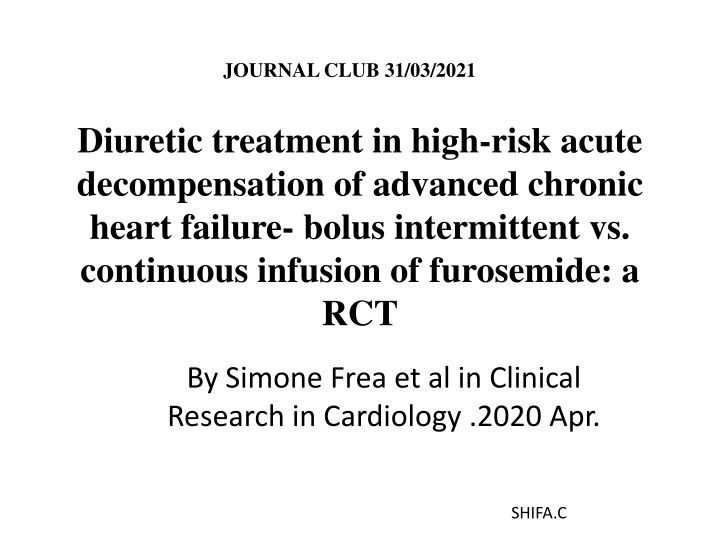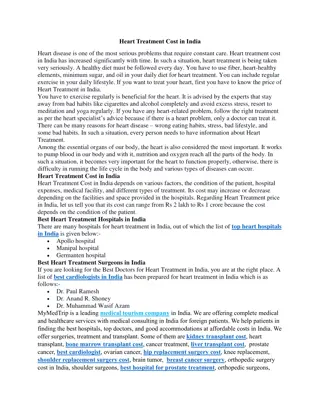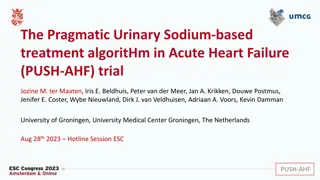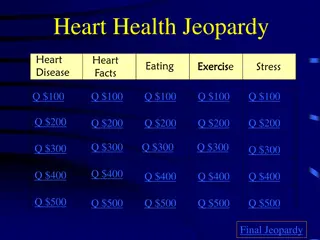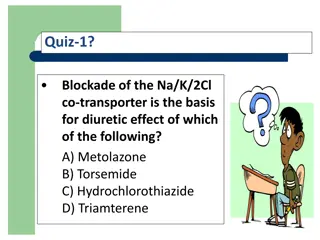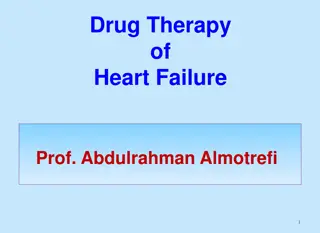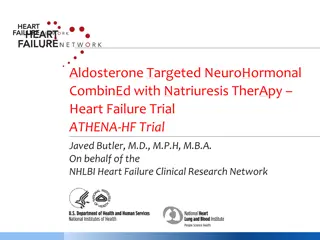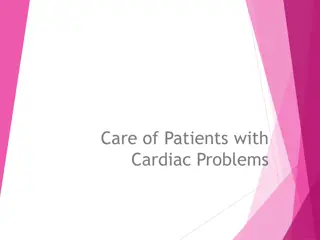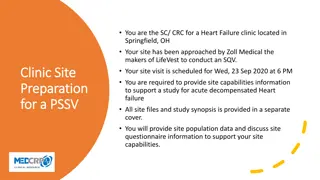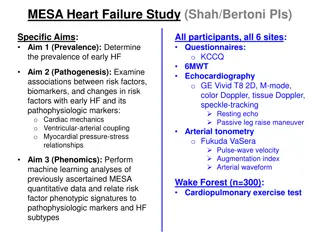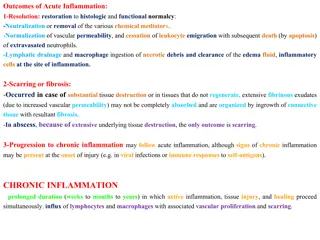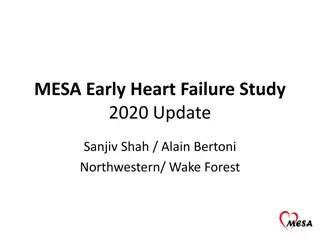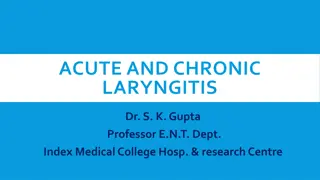Diuretic Treatment in High-Risk Acute Decompensation of Chronic Heart Failure
A randomized controlled trial comparing bolus intermittent vs. continuous infusion of furosemide in advanced chronic heart failure patients with diuretic resistance. Explore indications, dosing modifications, major adverse reactions, and mechanisms of diuretic resistance.
Download Presentation

Please find below an Image/Link to download the presentation.
The content on the website is provided AS IS for your information and personal use only. It may not be sold, licensed, or shared on other websites without obtaining consent from the author.If you encounter any issues during the download, it is possible that the publisher has removed the file from their server.
You are allowed to download the files provided on this website for personal or commercial use, subject to the condition that they are used lawfully. All files are the property of their respective owners.
The content on the website is provided AS IS for your information and personal use only. It may not be sold, licensed, or shared on other websites without obtaining consent from the author.
E N D
Presentation Transcript
JOURNAL CLUB 31/03/2021 Diuretic treatment in high-risk acute decompensation of advanced chronic heart failure- bolus intermittent vs. continuous infusion of furosemide: a RCT By Simone Frea et al in Clinical Research in Cardiology .2020 Apr. SHIFA.C
FUROSEMIDE Potent loop diuretic Sulfamoylanthranilic acid derivative Inhibits Na-K-2Cl pump at ascending limb of LoH, PCT & DCT Onset 5 min iv, 30-60 min (PO) Peak - <15 mins iv, 1-2 hr (PO)
Duration 2 hrs iv, 6-8 hrs PO Metabolized in liver(10%) t1/2 - 30-120 min (normal renal function), 9 hrs in ESRD 91-99% protein bound, Not dialyzable Urinary excretion
Indications 1. Edema CCF, CLD, renal disease including nephrotic syndrome. 2. Resistant hypertension 3. Acute pulmonary edema / hypertensive crisis/ raised ICP 4. Hyperkalemia in ACLS 5. Hypermagnesemia in ACLS
Dosing modifications- 1. Acute renal failure- 1-3 g/day , avoid use in oliguria 2. Hepatic impairment monitor LFT
Major adverse reactions- 1. AKI 2. Hypovolemia, hypokalemia, hypocalcemia, hypomagnesemia. 3. Hypersensitivity reactions 4. Ototoxicity
Background Diuretic resistance - common in acute decompensation of advanced chronic heart failure. Failure to achieve therapeutically desired reduction in edema despite full dose of diuretic.
Mechanisms 1. decreased renal blood flow 2. hypoproteinemia 3. uremia- in patients with CKD
Risk factors for diuretic resistance 1.Hypotension 2.Hyponatremia 3.Severe renal dysfunction 4.Severe heart failure 5.Daily need of high dose diuretic
Literature DOSE study the largest prospective double- blind RCT, 308 patients - No significant difference between bolus & continuous infusion Metaanalysis by Kuriyama.A, Urushidani.S (2019) bolus is superior
No proper evidence of comparison in patients at high risk of diuretic resistance Licata et al continuous infusion over intermittent bolus in refractory CCF when using hypertonic salt solution.
Methods The DRAIN study (Diuretic Response in Advanced Heart Failure- bolus vs. continuous Infusion). Single-centre, double-blind, double dummy randomised trial Screened all consecutive patients with acute decompensation of ACHF from May 2013- Dec 2016 in a University Hospital in Turin.
Sample size 80 90-day follow up after index hospitalization.
Inclusion criteria Age >/ 18 years ACHF EF at admission </ 30% High risk for diuretic resistance (SBP </ 110, S.Na </135, severe congestion wet score >/12/18)
Exclusion criteria Reversible causes of acute heart failure (ACS, myocarditis ,acute pulmonary embolism, arrhythmias, severe primary organic valve disease) Cardiogenic shock at admission eGFR <15 mL/min/1.73m2
1:1 ratio frusemide bolus every 12 hours and continuous infusion. Continued up to 72 hours. All received a bolus (40 or 60mg) in the Edat admission.
Furosemide dose (low dose 120 mg/day vs. high dose -240mg/day) defined before randomisation. High dose arm - Severe systemic congestion (wetscore >/ 14 out of 18) - daily oral furosemide equivalent dose >/ 125mg - On supplemental metolazone therapy
After 48 hours dose could be lowered as per treating physician s discretion. Pharmacological mx and CPAP when indicated. Prespecified pharmacological protocol for all Thiazide diuretics not allowed Water restriction to 1000 mL/day All patients laid in bed
Primary end-point Freedom from congestion -JVP <8cm -no orthopnoea -trace peripheral edema or no edema
Secondary endpoints: -Total urinary output after 72h -Treatment failure ( persistent congestion with the need for increasing diuretic until RRT at 72 h) -Worsening RFT at any time -Diuretic response after 72h -Worsening or persistent heart failureuntil 72 h -Variations of NT-proBNP after 72h
Statistics All data were analyzed with intention to treat. P value<0.05 statistically significant. Analysed with SPSS 20.0
Results 40 patients in each treatment arm Mean daily frusemide 216 mg in continuos infusion & 195 mg in the intermittent bolus arm. 57 high dose, 23-low dose 77 patients completed the 72h protocol 3 patients left before 72h d/t cardiogenic shock, were included in the analysis.
Freedom from congestion 48% vs 25%, p value =0.04) Urinary output after 72 hrs 10,020 +-3032 vs 8612 +- 2984 , p value0.04 Treatment failure 15% vs. 38%, p value 0.02 No significant difference between incidence worsening renal function
Worsening heart failure at 72h- infusion arm - 20% , bolus arm 30% Change in NT-pro BNP similar 90 day follow-up 6 died, 4 underwent LVAD implantation, 2 underwent heart transplantation.
Subgroup analysis Furosemide bolus vs. infusion comparison in: -with or without severe renal dysfunction -with or without hemodynamic cold profile at admission -High vs. low dose. The primary end-point occurred less in the continuous infusion arm with a warm profile at admission. Other subgroups- neutral
Discussion Faster decongestion & greater diuretic response without higher incidence of worsening RFT in continuous infusion More constant diuresis without wide swings in intravascular volume & avoids the post-diretic sodium rebound.
Greater diuresis in the continuous infusion arm- significant clinical benefit. More patients achieved complete decongestion. Less patients needed a diuretic dose hike.
DRAIN vs. DOSE trial difference outcomes may be due to the populations enrolled. DRAIN patients at high risk for diuretic resistance could be more sensitive to continuous infusion.
RFT worsening was not associated with greater diuretic response, greater decongestion, or high dose diuretics. - Severely congested patients- lowering renal vein pressure- could improve renal function. - Effective decongestion more important than transient RFT worsening in long-term.
Subgroup analysis continuous infusion more effective in patients without severe renal dysfunction & without a cold-profile.
Limitations 1. Sample size is 80 2. Uneven distribution of furosemide dosages in both groups 3. Other factors- degree of congestion, right heart function,diuretic responsiveness. 4. Enrolled only advanced heartfailure patients with highrisk of diuretic resistance. 5. Thiazideswere not allowed
Conclusion - Continuous infusion of iv furosemide was associated with better decongestion without worsening RFT , - as compared with intermittent boluses in patients with acute decompensation of advanced heart failure with high risk of diuretic failure.
